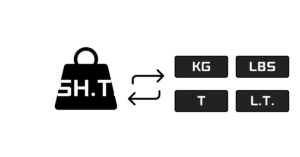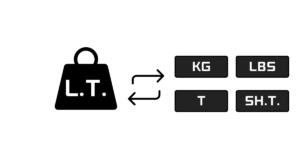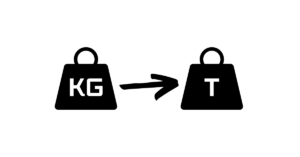Convert metric ton to kilogram, pound, short ton (US) and long ton / imperial ton (l.t).
Converting Metric Ton
Metric Ton Converter: An In-Depth Guide
Introduction
The metric ton, also known as the tonne, is a unit of mass in the metric system equivalent to 1,000 kilograms. It is extensively utilized in various industries and applications globally, especially in international trade, shipping, and large-scale manufacturing. Having a grasp on how to convert metric tons to other units of mass is essential for professionals in these sectors, as well as for students and individuals working with international measurements.
This detailed guide will delve into the metric ton converter, offering comprehensive information on converting metric tons to kilograms, pounds, long tons, and short tons. We will discuss the conversion factors, step-by-step procedures, practical uses, and suggestions for precise conversions.
1. Understanding the Metric Ton
Before delving into conversions, it is crucial to comprehend what a metric ton signifies:
• Definition: A metric ton (symbol: t) is equivalent to 1,000 kilograms or roughly 2,204.6 pounds.
• Origin: It was introduced as part of the metric system in the 19th century.
• Usage: Widely employed in international shipping, agriculture, and industrial sectors.
Key points:
– 1 metric ton = 1,000 kg
– Referred to as a “tonne” in numerous countries
– Distinct from the US “short ton” and the UK “long ton”
2. Metric Ton to Kilogram Conversion
Converting metric tons to kilograms is simple due to the base-10 structure of the metric system.
Conversion factor:
1 metric ton = 1,000 kilograms
Formula:
Kilograms = Metric tons × 1,000
Example:
To convert 5.7 metric tons to kilograms:
5.7 × 1,000 = 5,700 kilograms.
Practical application:
When dealing with shipping, it is common to encounter weights listed in metric tons. To convert these weights to kilograms, simply multiply the metric ton value by 1,000. For example, a container weighing 12.5 metric tons would be equivalent to 12,500 kilograms.
3. Metric Ton to Pound Conversion
Converting metric tons to pounds can be done using a conversion factor of 1 metric ton ≈ 2,204.62262 pounds. To illustrate, 3.2 metric tons would be approximately equal to 7,054.79 pounds.
Alternatively, you can first convert the metric tons to kilograms, then to pounds. For instance, 3.2 metric tons would be equivalent to 3,200 kilograms, which in turn would be approximately equal to 7,054.79 pounds.
Practical application:
For instance, a truck’s payload capacity of 8.5 metric tons can be expressed as approximately 18,739.29 pounds.
4. Metric Ton to Long Ton Conversion
The long ton, also known as the imperial ton, is used in the United Kingdom and some Commonwealth countries. To convert metric tons to long tons, you can use the conversion factor of 1 metric ton ≈ 0.9842065276 long tons. For example, 6.8 metric tons would be approximately equal to 6.6926 long tons.
Practical application:
For example, a ship’s cargo of 15,000 metric tons would be approximately equal to 14,763.10 long tons.
5. Metric Ton to Short Ton Conversion
The short ton is commonly used in the United States and Canada. To convert metric tons to short tons, you can use the conversion factor of 1 metric ton ≈ 1.1023113109 short tons. For instance, 4.5 metric tons would be approximately equal to 4.9604 short tons.
Practical application:
For instance, a mining operation extracting 250,000 metric tons of ore would be approximately equal to 275,577.83 short tons.
6. Practical Applications of Metric Ton Conversions
Understanding metric ton conversions is essential in various industries and scenarios:
a) International Trade:
• Shipping manifests frequently utilize metric tons
• Customs declarations may necessitate weights in different units
• Trade agreements might specify quotas in various weight units
b) Agriculture:
• Crop yields are often measured in metric tons
• Feed and fertilizer quantities may require conversion for international orders
c) Construction:
• Building materials like steel and concrete are often measured in metric tons
• Load-bearing calculations may require conversion to local units
d) Environmental Science:
• Carbon emissions are frequently measured in metric tons
• Waste management often uses metric tons for large-scale measurements
e) Mining and Metallurgy:
• Ore extraction is typically measured in metric tons
• Metal production and trading use various weight units
f) Transportation:
• Vehicle weight limits may be in different units depending on the country
• Fuel consumption for ships and large vehicles is often calculated per metric ton of cargo
7. Tips for Accurate Conversions
To ensure precise conversions when using a metric ton converter, consider the following tips:
a) Use Appropriate Precision:
• Match the number of decimal places to the precision of your original measurement
• Be aware of significant figures in scientific and engineering applications
b) Double-Check Your Work:
• Perform reverse calculations to verify your results
• Use multiple conversion methods when possible
c) Understand Rounding:
• Know when to round numbers and to how many decimal places
• Be consistent in your rounding approach across calculations
d) Use Reliable Tools:
• Employ certified conversion calculators or software
• Keep conversion factors updated, especially for regulated industries
e) Consider Context:
• Understand the required precision for your specific application
• Be aware of industry standards and regulations re.
f) Document Your Process:
• Note the conversion factors and methods used
• Keep a record of original and converted values for reference
8. Common Errors in Conversion and How to Prevent Them
When utilizing metric ton converters, it is important to avoid the following common mistakes:
a) Confusion of Units:
• Mixing up metric tons with long or short tons
• Confusing kilograms and pounds during intermediate steps
Solution: Clearly label the units used throughout the conversion process.
b) Errors in Decimal Placement:
• Misplacing decimal points can result in significant inaccuracies
Solution: Utilize scientific notation for very large or small numbers to maintain accuracy in decimal placement.
c) Premature Rounding:
• Rounding off intermediate results can lead to cumulative errors
Solution: Retain additional decimal places during calculations and only round off the final outcome.
d) Neglecting Regional Discrepancies:
• Assuming that all countries utilize the same weight units
Solution: Verify the standard weight units employed in the specific countries or industries involved.
e) Inconsistent Application of Conversion Factors:
• Employing different sources for conversion factors within the same calculation
Solution: Stick to a single reliable source for all conversion factors within a particular project.
9. Advanced Considerations
For individuals necessitating precise conversions or operating in specialized fields:
a) Impact of Temperature:
• In certain scientific contexts, the mass of an object may slightly fluctuate with temperature
• For highly accurate work, consider temperature coefficients of expansion
b) Gravitational Variances:
• The weight of a mass can slightly differ based on location due to gravitational variations
• In meticulous scientific endeavors, this factor may need to be taken into account
c) Industry-Specific Norms:
• Certain industries have their own standardized conversion factors
• Always refer to industry-specific guidelines when conducting conversions
d) Digital Systems and Data Input:
• When entering converted values into databases or software, be mindful of system restrictions on decimal places or total digits
• Ensure that the converted values align with the data types utilized in your systems.
Future Directions in Weight Measurement and Conversion
The evolution of technology and the expansion of global trade are driving changes in weight measurement practices:
a) Growing Adoption of the Metric System:
• More and more countries are switching to the metric system, potentially streamlining conversions in the future
b) Integration of Digital Technologies:
• Advanced sensors and Internet of Things (IoT) devices are making real-time weight measurement and conversion increasingly prevalent
c) Utilization of AI and Machine Learning:
• These innovations may result in more advanced conversion tools capable of adjusting to specific contexts and industry requirements
d) Incorporation of Blockchain in Trade:
• Blockchain technology could be employed to guarantee the precision and traceability of weight measurements and conversions in international trade
In conclusion, mastering the utilization of a metric ton converter is imperative for individuals operating in sectors dealing with extensive measurements, international trade, or scientific fields. By comprehending the conversion factors and procedures for translating metric tons into kilograms, pounds, long tons, and short tons, you can guarantee accuracy in your computations and efficiency in your tasks.
Keep in mind that though conversion tools and calculators are readily accessible, possessing a strong understanding of the fundamental principles enables you to verify outcomes and identify potential mistakes. Always take into account the context of your conversion, the necessary level of precision, and any industry-specific guidelines that may be relevant.
Given the ongoing expansion of global trade and the growing interconnectedness of industries, the ability to confidently convert between different units of mass will continue to be a valuable expertise. Whether you are a student, a professional, or simply someone intrigued by global measurements, proficiency in metric ton conversions will prove beneficial in our interconnected world.







